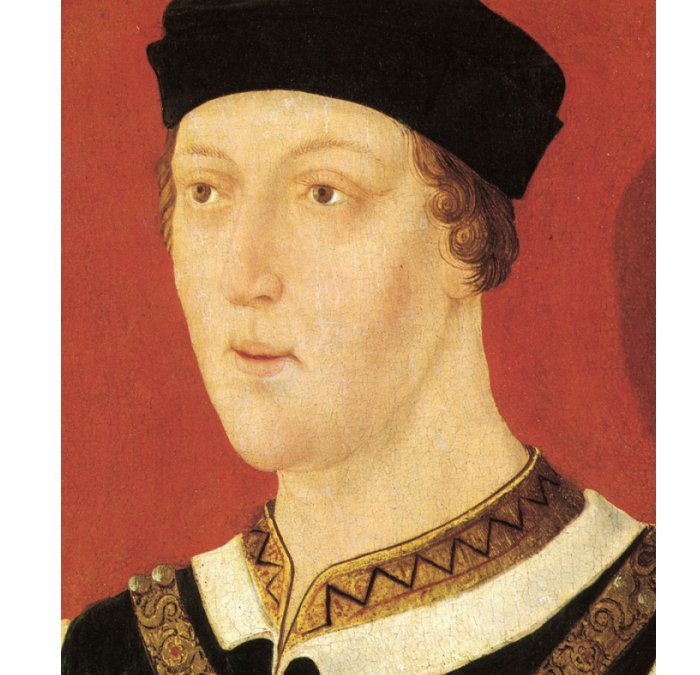Wars Of The Roses: Thirty Two Years Of Struggle To Claim English Throne
A. Sutherland - AncientPages.com - The Wars of the Roses was a civil war in England that lasted from 1455-1487. This thirty-two-year military conflict was fought between the supporters of the House of Lancaster (Lancastrians) and the supporters of the House of York (Yorkists).
Finding Richard's circlet after the battle, Lord Stanley hands it to Henry at the Battle of Bosworth Field, 1485. Engraving, 19th century. Image via Warfare History Network
The name of the wars is related to the roses; a red rose represents the Lancastrians (House of Lancastrians) and the Yorkists by a white rose.
It was a struggle to claim the right to the English throne, and each side sincerely believed they had a rightful claim. The Lancastrians and the Yorkists were two of England's most influential great aristocratic families.
Another important figure in this conflict was an English nobleman, administrator, and military commander, Richard Neville, 16th Earl of Warwick (1428 – 1471). He was wealthy and powerful, with political connections beyond the country's borders.
Neville was initially on the Yorkist side but later switched to the Lancastrian side, and in fact, he was instrumental in the deposition of two kings.
The dispute between the two houses began with the overthrow of King Richard by Henry Bolingbroke, Duke of Lancaster, in 1399. Henry Bolingbroke ( c. April 1367 – 20 March 1413), crowned Henry IV, was King of England from 1399 to 1413, but his rule was widely unpopular. Shortly, a revolt broke out in Wales, Cheshire, and Northumberland, and Henry IV managed to suppress the revolts with difficulty.
He died in 1413, and his successor was Henry V, a popular king and a strong leader who led England against France in the Hundred Years' War (1337 to 1453) and won many battles, giving the Lancastrians enough power to hold on to the throne. When Henry V died in 1422 from dysentery, his son, Henry VI, became his successor as King of England and France, but he had many difficulties in ruling the country. He had a mental illness inherited from his French grandfather, Charles VI.
Henry was an ineffective ruler, surrounded by some unpopular advisors such as Cardinal Beaufort, the Duke of Gloucester, and the Duke of Suffolk When Henry VI's life was about to end, the Yorkists were almost sure their representative would have a right of succession after him.
Henrik VI (1421-1471), Image credi: Anonymous - Public Domain
However, it was not that simple. The new King did not inherit the throne; instead, he was elected. Parliament played an essential role in this challenging political process. It had the enormous power to create a king.
"..Haughty, arrogant kings bowed submissively to its will. Henry could not make laws nor impose taxes without first summoning Parliament and obtaining his subjects' consent. But corrupting influences were at work, which was destined to cheat England out of her liberties for many a year." 1
The country's impoverishment to pay for the war and royal extravagances had awakened a troublesome spirit in the House of Commons. Cruelty to heretics also, and oppressive enactments were fought and defeated in this body. The Kikingclergy, and nobles, were drawing closer together and farther away from the people, and were devising ways of stifling their will…" wrote an American author and historian, Mary Platt Parmele, in her "A Short History of England, Ireland, and Scotland."
At the same time, according to the strict rules of hereditary succession, there were two others with claims superior to Henry's. The Duke of Lancaster, Henry's father (John of Gaunt), was only a younger son of Edward III. Richard Duke of York, his cousin, claimed a double descent from Duke Clarence and the Duke of York, both sons of Edward III.
It is also said that another immediate cause of the York revolt related to Queen Margaret Anjou, who unexpectedly revealed her male child. It had raised serious doubts about the origin of the righteous bed and, of course, seriously contributed to the beginning of the Wars of the Roses, a gloomy and very destructive period in the history of England, where most of the fighting took place, which resulted in significant loss of life and property.
"…Murders, executions, treacheries, adorn a network of intrigue and villainy, … was enough to have made the "White" and the "Red Rose" forever hateful to English eyes."
Many more significant battles and minor clashes occurred between the fighting parts; however, the last and decisive battle military encounter is known as the Battle of Bosworth Field (or Battle of Bosworth).
Henry VII (1457 – 1509), an offshoot of the House of Lancaster), raised a Lancastrian army against Richard III, defeated the Yorkists, and killed Richard at the Battle of Bosworth Field in 1485.
After this battle, the throne of England finally fell to the representative of a strong family - Henry Tudor.
Henry VII was crowned King and married Edward IV's daughter, Princess Elizabeth of York - a move to end the very tiring and devastating period in the history of England - Wars of the Roses. He reunited the two royal houses, merging the rival symbols of the red and white roses into the new emblem of the red and white Tudor rose.
The House of Tudor ruled the Kingdom of England until 1603.
Written by – A. Sutherland AncientPages.com Staff Writer
Updated on October 2, 2022
Copyright © AncientPages.com All rights reserved. This material may not be published, broadcast, rewritten or redistributed in whole or part without the express written permission of AncientPages.com
Expand for referencesReferences:
- Mary Parmele, History of England
More From Ancient Pages
-
 Glastonbury Tor – One Of The Most Mysterious Sacred Places In England
Civilizations | Aug 30, 2018
Glastonbury Tor – One Of The Most Mysterious Sacred Places In England
Civilizations | Aug 30, 2018 -
 Superior Sword Of Goujian: Jian Weapon And Legend Of Immortal With Good Advice
Artifacts | Oct 15, 2019
Superior Sword Of Goujian: Jian Weapon And Legend Of Immortal With Good Advice
Artifacts | Oct 15, 2019 -
 Copper Artifacts Reveal Changing Connections In Prehistoric Europe
Archaeology | May 11, 2023
Copper Artifacts Reveal Changing Connections In Prehistoric Europe
Archaeology | May 11, 2023 -
 Wasabi Plant Can Save Ancient Bio-Deteriorated Papyrus
Scripts, Paintings & Inscriptions | Apr 4, 2024
Wasabi Plant Can Save Ancient Bio-Deteriorated Papyrus
Scripts, Paintings & Inscriptions | Apr 4, 2024 -
 Ancient Viking Age Music Recreated – This Is What It Sounds Like
Featured Stories | Sep 20, 2020
Ancient Viking Age Music Recreated – This Is What It Sounds Like
Featured Stories | Sep 20, 2020 -
 Ancient Greek Seven-Room Building And Treasures Found Underwater Off The Coast Of Salamis
Archaeology | Nov 1, 2023
Ancient Greek Seven-Room Building And Treasures Found Underwater Off The Coast Of Salamis
Archaeology | Nov 1, 2023 -
 Archaeologists Investigate The Mysterious Disappearance Of Human Skeletons In England And Wales During The 5th Century
Archaeology | Oct 16, 2024
Archaeologists Investigate The Mysterious Disappearance Of Human Skeletons In England And Wales During The 5th Century
Archaeology | Oct 16, 2024 -
 Ancient City Of Metsamor – Captured And Destroyed By Argishti I, The Ruler Of Urartu
Civilizations | Sep 11, 2015
Ancient City Of Metsamor – Captured And Destroyed By Argishti I, The Ruler Of Urartu
Civilizations | Sep 11, 2015 -
 Sir Walter Raleigh ‘Self-Portrait’ Discovered Behind Walls In The Tower Of London
Archaeology | Nov 5, 2018
Sir Walter Raleigh ‘Self-Portrait’ Discovered Behind Walls In The Tower Of London
Archaeology | Nov 5, 2018 -
 Gigantic Karnak Temple Complex: Advanced Ancient Technology In Egypt
Civilizations | Apr 6, 2017
Gigantic Karnak Temple Complex: Advanced Ancient Technology In Egypt
Civilizations | Apr 6, 2017 -
 Mictlan – Underworld Realm Of The Dead In Ancient Aztec Beliefs
Aztec Mythology | Jul 2, 2018
Mictlan – Underworld Realm Of The Dead In Ancient Aztec Beliefs
Aztec Mythology | Jul 2, 2018 -
 Mysterious Rongorongo Script Remains Undeciphered – Does It Contain A Prophetic Warning?
Featured Stories | Mar 24, 2014
Mysterious Rongorongo Script Remains Undeciphered – Does It Contain A Prophetic Warning?
Featured Stories | Mar 24, 2014 -
 Unexpected Danger Lurks Beneath Ancient Maya Cities – Mercury Pollution Discovered
Archaeology | Sep 23, 2022
Unexpected Danger Lurks Beneath Ancient Maya Cities – Mercury Pollution Discovered
Archaeology | Sep 23, 2022 -
 Swiss Farmer Discovered Roman Coins Among Cherry Trees
Archaeology | Nov 22, 2015
Swiss Farmer Discovered Roman Coins Among Cherry Trees
Archaeology | Nov 22, 2015 -
 3,000-Year-Old African Musical Instrument Can Help Modern Medicine
Archaeology | Sep 19, 2018
3,000-Year-Old African Musical Instrument Can Help Modern Medicine
Archaeology | Sep 19, 2018 -
 Lost Q Source Remains An Unsolved Biblical Mystery
Biblical Mysteries | May 7, 2017
Lost Q Source Remains An Unsolved Biblical Mystery
Biblical Mysteries | May 7, 2017 -
 On This Day In History: Foundation Stone Of The Royal Greenwich Observatory In London Was Laid – On August 10, 1675
News | Aug 10, 2016
On This Day In History: Foundation Stone Of The Royal Greenwich Observatory In London Was Laid – On August 10, 1675
News | Aug 10, 2016 -
 Ancient Secrets Of Sacred Lismore – Is There A ‘Second’ Iona In Scotland?
Archaeology | Jul 4, 2017
Ancient Secrets Of Sacred Lismore – Is There A ‘Second’ Iona In Scotland?
Archaeology | Jul 4, 2017 -
 2,000-Year-Old Rare Sarcophagus With Human Remains Discovered In Rock-Cut Cave In India
Archaeology | Jan 18, 2018
2,000-Year-Old Rare Sarcophagus With Human Remains Discovered In Rock-Cut Cave In India
Archaeology | Jan 18, 2018 -
 Large Statue Of Ancient Guardian Discovered At Angkor Wat
Archaeology | Aug 7, 2017
Large Statue Of Ancient Guardian Discovered At Angkor Wat
Archaeology | Aug 7, 2017



